Why Get The Best Water Filter For Chlorine Removal?
The crucial function chlorine has played as a water disinfectant for the past 100 years is undisputed by those who are aware of the facts. However, there have been legitimate issues and worries voiced about the effects of prolonged exposure to chlorine and its metabolites.
Due to this, a lot of homes are looking for catalytic carbon filters that can get the chemical out of their tap water. Here is our list of the top picks.
What Is Chlorine?
Chemical element chlorine is employed in a number of disinfection and protection processes. Our drinking water contains chlorine, and we also use it in some medications, household cleaners, and other things.
Why is Chlorine Added to Drinking Water?
In public water systems, chlorine is a key disinfectant that can get rid of pathogens like bacteria, viruses, and protozoa.
Chlorine protects water as it passes through underground pipes and into our houses from microbiological pollution. Here is further information on why chlorine is added to drinking water.
Is Chlorine in Tap Water Safe?
Chlorine in drinking water is safe in amounts up to 4 PPM (parts per million), according to the Environmental Protection Agency.
If chlorine weren’t present in water, there wouldn’t be anything to destroy harmful, disease-causing germs like bacteria. As a result, water would actually be less safe. Even though water with low amounts of chlorine is deemed safe, it doesn’t necessarily imply it’s good for you or that you’ll enjoy drinking it.
Many people dislike the chemical taste and odor that chlorine can impart to water. Studies discovered that chlorine in drinking water might produce cancer-causing chemicals, raising the possibility that chlorine may be more harmful than we previously thought.
Chlorine Effects on Skin and Hair
There is growing evidence that chlorine may have an impact on our skin and hair, even though the risks of drinking water with chlorine are hotly contested.
Particularly if it remains on our skin after a shower or bath, chlorine can harm our skin. Chlorine causes dryness and irritation by removing the natural oils from the skin’s surface. According to one study, atopic dermatitis, a painful condition that results in itchy, cracked, and irritated skin, may be brought on by a combination of hardness and chlorine in the water.
Additionally, hair can be harmed by chlorinated water. Chlorine prevents the scalp from properly hydrating the hair, leaving it dry and brittle and encouraging irritation and dandruff. Chlorine can hasten hair loss by drying out hair and promoting fading in coloured hair.
Best Water Filter for Chlorine Removal: Our Top List!
SpringWell Water Whole House Water Filter System
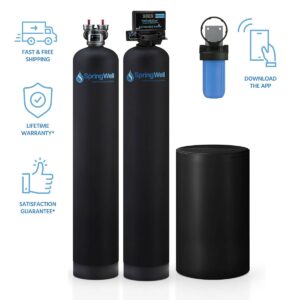
Features:
- Contaminants removed: 10+
- Testing/ Certifications: –
- Filter Lifespan: 1,000,000 gallons
- Annual Cost: ~$100
- Warranty: Lifetime
The SpringWell Whole House Water Filter System eliminates chlorine, PFAS, pesticides, and other toxins from the water supply in your house.
With four stages of carbon filtration and a 1,000,000 gallon capacity, this catalytic carbon and KDF filter prolongs the time the filter is in touch with water.
This SpringWell filtration system is a great choice if you want to get a good deal from a reliable company. This filter performs better than others at removing chlorine because it combines KDF and carbon.
Clearly Filtered Water Pitcher
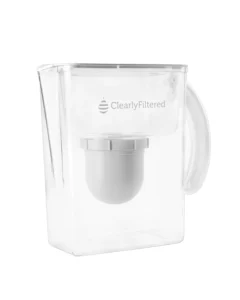
Features:
- Contaminants removed: 365+
- Testing/ Certifications: NSF 42, 53, 244, 401 & 473
- Filter Lifespan: 100 gallons
- Annual Cost: ~$150
- Warranty: Lifetime
Powerful water pitcher The Clearly Filtered uses affinity filtering technology to remove up to 99% of more than 365 pollutants. According to independent testing, this filter complies with NSF 42, 53, 244, 401, and 473 criteria.
The Clearly Filtered water filter pitcher is the best portable carbon filtration option for couples and small families because it has a 10-cup capacity.
Although water pitcher filters have a reputation for being less effective than other filtering techniques, the Clearly Filtered is the best filter on this list for removing contaminants. This water filter pitcher is the best of its kind if you’re searching for a convenient, portable chlorine filtration option.
Epic Pure Water Filter Dispenser
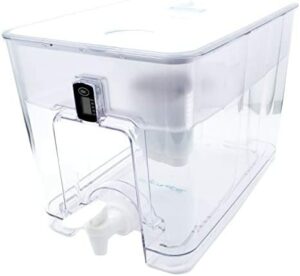
Features
- Contaminants removed: 200+
- Testing/ Certifications: NSF 42, 53, 401, P473 & P231
- Filter Lifespan: 150 gallons
- Annual Cost: ~$140
- Warranty: Lifetime
The Epic Pure Water Filter Dispenser is a half-gallon dispenser that has a 99.999% efficacy rate for removing more than 200 pollutants.
The lifespan of this dispenser filter, which uses gravity filtering, is approximately 150 gallons, or 3 to 4 months. NSF/ANSI Standards 42, 53, 401, P473, and P231 have been tested (but not certified) for the filter.
The Epic Pure is the ideal water filtration system for you if you want a no-install chlorine filter that is compatible with refrigerators. With the extra benefit of dispensing cold water directly from your refrigerator without having to remove the dispenser, this filter dispenser is a strong competitor to the Clearly Filtered.
Big Berkey Gravity-Fed Water Filter
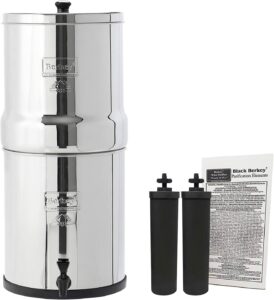
Features:
- Contaminants removed: 200+
- Testing/ Certifications: NSF 53
- Filter Lifespan: 6,000 gallons
- Annual Cost: ~$40
- Warranty: Lifetime
The Big Berkey is a 2.25-gallon countertop filter made of stainless steel that can get rid of more than 200 pollutants from drinking water.
This gravity water filtering system comes with two Black Berkey elements that have a combined lifespan of 6,000 gallons and is appropriate for 1-4 persons.
The Big Berkey is still the most widely used countertop water filter for a reason: it is the best of its kind. The Big Berkey is the ideal choice if you want access to more filtered water than a pitcher can offer while still seeking exceptional filtration and assured chlorine removal.
Epic Smart Shield
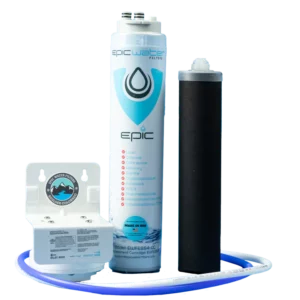
Features:
- Contaminants removed: 70+
- Testing/ Certifications: NSF 42, 53, 401
- Filter Lifespan: 651 gallons
- Annual Cost: ~$120
- Warranty: Lifetime
More than 70 tap water pollutants, including chlorine, are removed by the Epic Smart Shield using an activated carbon coconut filtration cartridge.
This under-sink chlorine filter provides excellent filtration for up to 650 gallons. The filter needs to be replaced once every 12 months under normal use. The system is built entirely in the USA from BPA-free components.
The Epic Smart Shield is proof that under-sink chlorine water filters don’t have to be cumbersome or challenging to install. This filter is small, simple to install, and incredibly cost-effective because it only needs one cartridge replacement a year.
PUR Plus Faucet Filtration System
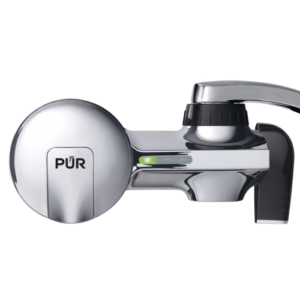
Features:
- Contaminants removed: 70+
- Testing/ Certifications: NSF 42, 53, 401
- Filter Lifespan: 100 gallons
- Annual Cost: ~$100
- Warranty: 2 years
To provide clean, filtered water, the PUR is a water filtration system that attaches to a kitchen faucet. More than 70 toxins, including lead, mercury, benzene, asbestos, pesticides & herbicides, medicines, and chlorine, can be eliminated or reduced by this method.
PUR filters employ activated carbon filters made from coconut shells to adsorb contaminants from tap water.
For those searching for a low-cost system that they don’t have to physically fill with tap water themselves, the PUR is the best water filtration option. PUR is a winner in terms of price and dependability, demonstrating that outcomes can be attained without spending a fortune.
AquaBliss High Output Revitalizing Shower Filter
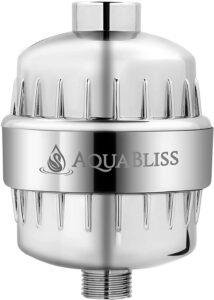
Features:
- Contaminants removed: 10+
- Testing/ Certifications: –
- Filter Lifespan: 12,000 gallons
- Annual Cost: ~$50
- Warranty: 1 year
The AquaBliss is a multi-stage shower water filtering device that can remove chlorine and add minerals to water.
The installation of this shower unit requires no equipment and may be used as a direct replacement for your current showerhead. The gadget can be mounted on any shower arm because of its universal fit.
While some shower filtration systems remove chlorine using inexpensive activated charcoal, the AquaBliss accomplishes much more. The performance of this product is the highest of any showerhead filtration system now available.
How To Test Chlorine in Water?
Test Kits
Depending on the kind of chlorine you wish to test for, there are a variety of chlorine test kits available on the market. For testing free chlorine, total chlorine, residual chlorine, etc., there are kits available.
Color Test Kits
When chlorine is present, a chemical tablet called DPD, which is used in color test kits, becomes pink. In comparison to digital meters, color test kits are far more affordable and much simpler to use. Additionally, if done correctly, the color test might produce reliable results.
Chlorine Test Strips
Another common technique for determining the amount of free chlorine in drinking water is to use chlorine test strips. This test can be used to determine the amount of chlorine in your home’s water supply, including total and free chlorine.
Simply take a piece of test strip from your kit and dip it into a sample of tap water to use the chlorine test strips (some may instruct you to hold it under running tap water, so be sure to read the instructions before using).
After a few minutes, the test strip’s color will change; after removing it from the water, compare its hue to the one on the color chart provided in your test kit. You can use the chart to estimate the chlorine content of your drinking water.
Digital Colorimeters
Consider purchasing a digital colorimeter if you’re seeking a more precise chlorine testing technique to determine the level of chlorine in drinking water. DPD tablets and an insertion vial method are the two options available for digital colorimeters.
The first one involves mixing a DPD pill with a water sample. As a result, the color will bleed, showing that the water contains chlorine. In order to read the intensity of color change by emitting wavelengths, the meter must be equipped with a vial.
Readings from digital colorimeters are quick and extremely accurate. For people who don’t want to wait around to find out how much chlorine is in their water, they are therefore perfect equipment.
Certified Laboratory Water Chlorine Testing
It’s possible that test strips and other at-home testing techniques don’t always yield the precise findings you need. In that scenario, you may always choose to submit a sample of your water to a recognized laboratory to have the quality of your chlorinated water evaluated.
If you want a more detailed guide for how to test chlorine in water, do check out our separate guide.
Water Filter for Chlorine Removal Buyer’s Guide
In this section, we’ve included a buyer’s guide to help you out before you shop for chlorine water filters.
How a Chlorine Filter Works
There are several types of chlorine water filter, which I’ve covered in more detail below. The type of filter will affect the exact filtration process that takes place.
In a traditional filter, water will pass through a filtration media and certain contaminants, including chlorine, will become trapped in the media’s pores.
Other types of chlorine removal systems may use different techniques to remove chlorine, such as boiling water and treating water with UV light.
Water Treatment Systems That Remove Chlorine
For removing chlorine, charcoal filters, reverse osmosis systems, UV lights, and distillation units are the most effective water treatment system types.
Carbon Filtration
Some of the most economical methods for eliminating chlorine from municipal water are activated and catalytic carbon filters.
The adsorption method used by these filters, which have enormous surface areas, traps pollutants in their media. Water particles are smaller than chlorine particles. This indicates that even though water can pass through the filter, chlorine cannot.
Catalytic carbon filters are superior to activated carbon filters because they have a greater surface area that can catch more impurities at once. Granular activated carbon media is still a good option for removing chlorine.
Reverse Osmosis
One of the greatest methods for treating water overall is a good reverse osmosis system, which eliminates more than 99.9% of all impurities, including chlorine.
Depending on the model, RO devices can be mounted on the kitchen countertop or beneath the sink. A reverse osmosis system includes a carbon filter and a semi-permeable membrane as two of the filtration stages. Only water atoms are able to pass through the membrane’s small pores.
Reverse osmosis systems may now filter out a wide spectrum of impurities by trapping particles larger than 0.0001 microns in size.
Any reverse osmosis system you purchase will lose some water throughout the filtration process. The major drawback of the RO approach to tap water filtration is this. The more recent reverse osmosis systems, however, are significantly more effective and less wasteful.
How much does a reverse osmosis cost? You might be surprised to find that out in our separate article.
UV Light
The majority of people are unaware that chlorine may be removed from water using UV light. The main goal of UV purification is to eradicate bacteria and viruses that spread disease. It accomplishes this by emitting UV rays with up to 400 nm in wavelength.
Not only do these wavelengths destroy bacteria. Additionally, they result in chemical processes that can eliminate up to 15 ppm of chlorine or chloramine from water.
A UV lamp can be used independently or as an addition to a larger filtration system. UV purification is only effective against chlorine and germs because it cannot remove pollutants from the water.
While excessive chlorine levels will ruin most water filters, they won’t have an impact on UV lights.
The typical lifespan of UV lights is one year. You’ll then need to replace the lamp with a new one.
Distillation
Another way of purifying water is distillation. A distillation system is exceptionally good at getting rid of chlorine and practically all other contaminants from drinking water.
Water is heated in a boiling tank until it evaporates during the distillation process. This water moves through a cooling passageway, where it condenses. Water droplets are created one at a time during the protracted process of condensation. In a spotless container, the condensed water is collected.
Boiling can evaporate chlorine, but it cannot condense at a temperature where water can. This implies that distillation can successfully remove chlorine particles. When water flows through a carbon filter in the distiller’s spout, any chlorine that manages to condense with water will be filtered out.
Most other pollutants, including lead, germs, and pesticides, cannot also evaporate with water. These impurities are left in the boiling chamber and can be cleaned up by washing them away.
What Type of Filter Removes Chlorine?
At this time, RO water filters, chlorine balls purifiers, activated carbon water filters, KDF water filters, ultrafiltration water filters, medicinal stone purifiers, etc. are examples of filter technologies that may successfully remove chlorine from water.
Maifan Stone Water Filter. Maifan Stone has a purifying function that can eliminate 5–10% of the residual chlorine in bleaching powder by absorbing some residual chlorine molecules. The typical service life is one to three months. Remaining chlorine is not effectively removed, and the filtered water cannot be used for drinking.
Ultrafiltration Water Filter. With a residual chlorine removal rate of 10–20% and a long useful life, the ultrafiltration membrane can filter bleaching powder and residual chlorine in a free molecular form with a filtration precision of up to 0.01 micron.
KDF Water Filter. The high-purity alloy used in the KDF water filter undergoes a redox reaction with residual chlorine, which can then be transformed into chlorine ions that are safe for human consumption. The service life is 12 to 24 months, and the elimination rate of residual chlorine is 20 to 30%.
Activated Carbon Water Filter. The majority of the bleaching powder and remaining chlorine may be absorbed by the super adsorption capacity, and the removal rate of the remaining chlorine can reach 90–95%. The adsorption capacity of activated carbon increases with increasing iodine number, and residual chlorine is removed more quickly. Activated carbon has a limited shelf life and can only be used continuously for three weeks. The effect of water purification will be lost if it is not refilled in a timely manner.
The Residual Chlorine Ball Purifier removes residual chlorine in the water body, including combined residual chlorine and free residual chlorine ClO- (hypochlorite ion), HOCl (hypochlorous acid), Cl2 (chlorine gas), etc., and converts the chlorine element of tap water into a harmless or beneficial element for humans. Its chemical composition is calcium hydrogen sulfite CaSO3, and the amount should not be too high. The duration is 8 to 12 months, and the eradication rate is very nearly 100%.
Reverse osmosis (RO) water filter. The reverse osmosis water filter uses a five-stage filtration combination, a pure physical filtration mechanism driven by pressure, and modern international RO membrane technology. The filtration precision is as high as 0.0001 microns. Nearly all of the remaining chlorine has been removed.
Considerations When Purchasing a Water Filter for Chlorine Removal
It’s important to take into account the following things before purchasing a chlorine water filter:
Application
What motivates you to purchase a chlorine water filter? Do you only want the chlorine in your drinking water removed? Or do you want to take chlorine out of the entire water system in your house? Maybe you just don’t want to take a chlorine-filled shower?
What kind of chlorine water filter is best for you will depend on how much chlorine needs to be removed. A drinking water filter, a shower water filter, and a whole-house filtration system are the three different ways chlorine can be removed.
The appliances, faucets, and showerheads in your home receive clean water through whole-house chlorine water filters that are connected to your home’s water supply. You can take a shower in chlorine-free water and wash your dishes and clothes in chlorine-free water. You will also have chlorine-free drinking water.
Drinking water filters for chlorine take the chlorine out of the water. You can filter your drinking water with a faucet filter, under-sink unit, or water filter pitcher.
Showerhead filters remove chlorine from your shower water by attaching to your existing shower line or installing in its place. Your choice of filter application will rely on the rationale behind your desire to remove chlorine from your water.
Filter Capacity
The capacity of a filter is a measurement of how many gallons of water it can produce each day. The filter’s ability to produce larger amounts of water increases with filter capacity. Bigger isn’t necessarily better, though.
The capacity of the filter you choose should be sufficient to deliver chlorine-free water on demand whenever you require it. For whole-home water filters, getting the proper capacity filter is particularly crucial. If your demands are too great for the filter’s capacity, the filter may not be able to handle them. Your water pressure may as a result considerably decrease.
Find out how much water your family uses each day to determine the filter capacity you require. Calculate a daily average from your readings over the course of a week if you have a smart meter. Choose a system that provides just a little bit more water than you require by comparing your daily water usage to the maximum filter capacity in GPD.
Point-of-use filters simplify the issue of filter capacity. A steady stream of water is delivered by showerhead filters.
You will have adequate water from a showerhead filter as long as the water pressure in your home is strong. However, compared to whole-home filters, these filters can have a lower lifespan.
Your water supply may be cut off to the drinking water filters. In this scenario, your filter will need to be refilled with water each time you finish the supply of filtered water. Less frequently will you need to refill the filter as its holding capacity increases.
Your under-sink water supply might be connected to a drinking water filter. Here, capacity is more crucial, but most filters can supply enough water to meet your needs for drinking.
Flow Rate
Flow rate and capacity are related. The flow rate increases when a system can deliver more filtered water each day.
Again, with whole-home water filters, flow rate is crucial. The water from these filters must be delivered swiftly enough to supply many appliances, such as your shower, washing machine, and dishwasher, all at once.
Systems typically range in size from 5 to 14 GPM. A 7–10 GPM flow rate system will be adequate for a typical home with 1-2 bathrooms.
Even if some shower head filters are better than others, they should be made to filter water without stopping the flow. If you have a power shower, you should research chlorine filters for high water pressure by reading user reviews.
Depending on the type you choose, a drinking water filter system’s flow rate will vary. For example, a water filter pitcher will take the longest to filter water because it uses gravity filtration.
On the other hand, filters that are powered by electricity or water pressure would have a faster water flow and be able to deliver water practically quickly.
Certifications
Manufacturers of water filters can apply to have their filters evaluated and approved by NSF International, a third-party certification body.
If a water filter gets an NSF certification, it means that it performs as promised in terms of removing particulate impurities.
You can seek for the following certifications in a chlorinated water filter:
NSF 42 – this is the main certification to look out for, as it indicates that a water filter has been tested and certified to remove chlorine, taste and odor.
NSF 53 – indicates that a filter is capable of removing health-hazardous contaminants, like lead. Many filters with an NSF 42 certification are also NSF 53 certified.
NSF 58 – reverse osmosis systems that reduce water’s TDS by at least 75% can obtain an NSF 58 certification.
Although it’s not necessary, you could feel more secure making an investment in a system that has received NSF certification. Be aware that filters marketed as having passed NSF testing are not genuinely NSF certified.
Installation & Maintenance
The installation and maintenance requirements of your chlorine water filter will depend on the model you choose.
Chlorine filters for entire homes require the most time-consuming, difficult installation. To install the system such that it intercepts the flow of your water, you will need to make a cut in your water line. When performing maintenance, you might also need to install a bypass valve to send water around your filter.
Chlorine water filters for showerheads are normally quite simple to install; all you need to do is screw the filter into your shower line and turn on the water to prime the filter.
Since you must once more cut into your water line, installing an under-sink drinking water filter can be a little trickier. Water filter pitchers and other standalone filters don’t even need to be installed.
You must replace the filters in a filtration system to keep it functioning properly. In the long run, multi-filter systems will be more expensive to maintain than single-filter systems.
Certain systems necessitate filter replacements more frequently than others. Look for systems with a filtering media that tends to last longer or units with a filter life of at least six months if you want to minimize maintenance.
Additional Factors to Look Into:
1. A front water filter. The front water filter is the first line of defense in the home and is put behind the water meter. Impurities, bacteria, colloids, macromolecular organic debris, and other dangerous elements can all be removed from the water with this filter.
A filter-type pre-water purifier is advised if the tap water pipeline in your neighborhood is new and made of PE and other plastics due to the low level of pollutants in the water. The filter element does not need to be changed, however it can be cleaned sometimes.
A filter-type pre-water purifier with higher filtration accuracy is advised if the water in your neighborhood comes from an old iron pipeline and contains a lot of pollutants.
2. A water terminal filter. Ultrafiltration and RO (reverse osmosis) water filters are the most popular options for terminal water filters. The ultrafiltration core water filter element is different from the RO membrane since it is an ultrafiltration membrane. The ultrafiltration water filter’s core filtration process only consists of three stages: a PP cotton filter element, an ultrafiltration membrane, and activated carbon.
The fourth stage is an additional PP cotton filter element, and the fifth stage typically consists of both an additional PP cotton filter element and an activated carbon filter element. Ultrafiltration has the advantage of high effluent speed, no wastewater generation, and cheaper use costs than RO, however it cannot filter heavy metals and scale.
Additionally, the RO process uses three primary filters: pre-PP cotton filter, RO membrane, and activated carbon. The benefit of RO is that it generates clean water that is 100% safe and healthful; the drawback is that wastewater is produced, the water outlet is slow, and the cost of operation is higher than with ultrafiltration.
If you choose the RO reverse osmosis model, you should be aware that there are two sorts of RO water filters: those with tanks and those without. The storage bucket takes up a lot of space, requires large installation space, and the water flow is typically small with a flow rate of approximately 50 gallons per hour. The advantage of the bucket type is that the use cost is cheap and the probability of damage to the pump is minimal.
The large flow rate of the barrelless type means that the RO reverse osmosis membrane loss is high, the use cost will increase, and the likelihood of water pump damage will increase. However, the large flow rate also means that the RO reverse osmosis membrane loss is high, the use cost will increase, and the installation space required will decrease.
It is imperative to select a water filter with a good dechlorination effect because free water still contains chlorine after disinfection. Reverse osmosis water filters often have the best results at removing chlorine.
Installing a RO water purifier in your home is advised if you live in a city with hard water because it may almost completely remove chlorine from the water and raise the quality to the point of direct drinking.
Frequently Asked Questions
Can chlorine evaporate if you leave it long enough?
Yes. You may let it sit in a water pitcher overnight to remove chlorine for nothing at all. The chlorine in your water should have mostly dissipated by morning.
The evaporation of chlorine has some drawbacks. For starters, you can’t gauge how well the process is working or how much chlorine has been removed from your water. And secondly, don’t expect to have access to chlorine-free water right away. It would be necessary for you to prepare ahead of time by storing your water at least 8 hours before you intended to drink it.
Does boiling water remove chlorine?
If you’re wondering if boiling water removes chlorine, then yes it does. The process of chlorine evaporation is sped up by boiling water. One of the few pollutants, chlorine, will evaporate from water when it is heated.
Once more, this procedure is free. You’ll need to wait until the water cools before you can drink it, and heating water before drinking can be a hassle. Additionally, it is impossible to establish the ideal boiling time for chlorine elimination in water.
How much chlorine can a water filter remove?
Between 90 and 99% of the chlorine in water can be removed by a standard chlorine water filter. A water filter seldom eliminates all chlorine. But even a water filter that removes 90% of the chlorine will make your water taste and smell chlorine-free.
Is it safe to remove chlorine from water?
Yes. A chlorine water filter will remove chlorine from your water without reintroducing the hazardous germs that chlorination eliminates from your drinking water. By the time you arrive to drink your water, the chlorine has already completed its task and is no longer required.
